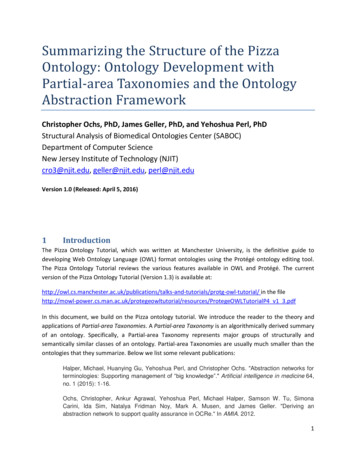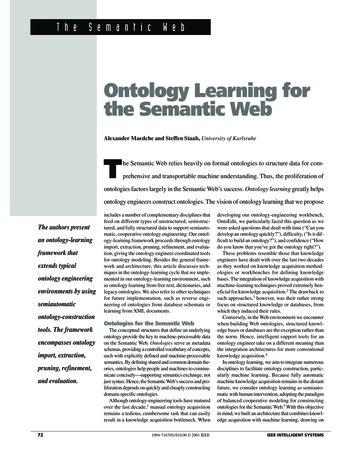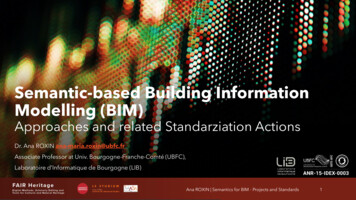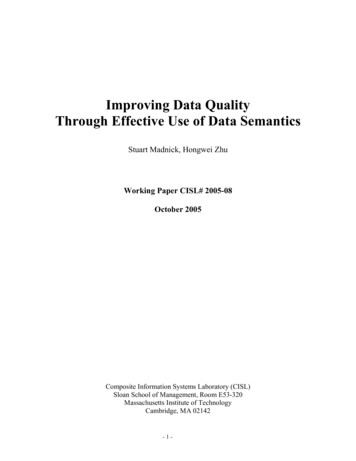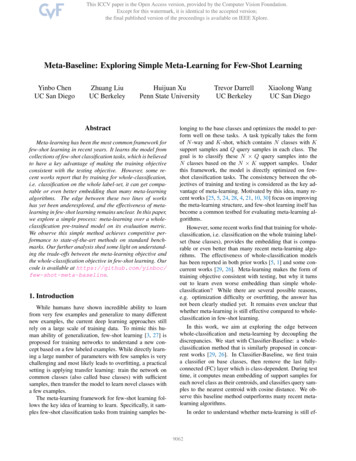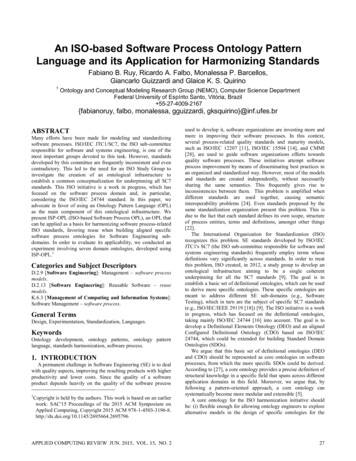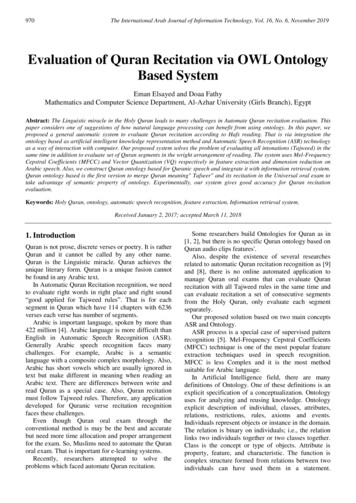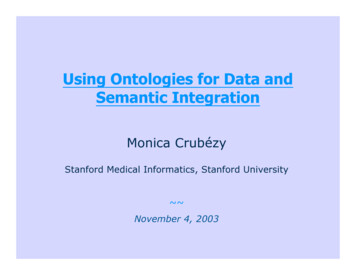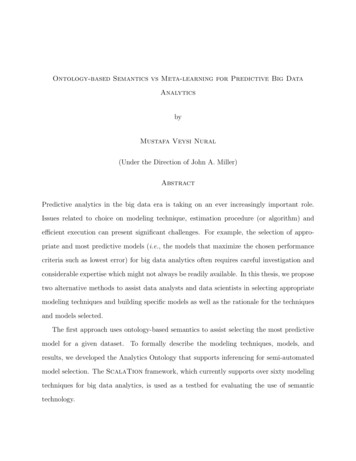
Transcription
Ontology-based Semantics vs Meta-learning for Predictive Big DataAnalyticsbyMustafa Veysi Nural(Under the Direction of John A. Miller)AbstractPredictive analytics in the big data era is taking on an ever increasingly important role.Issues related to choice on modeling technique, estimation procedure (or algorithm) andefficient execution can present significant challenges. For example, the selection of appropriate and most predictive models (i.e., the models that maximize the chosen performancecriteria such as lowest error) for big data analytics often requires careful investigation andconsiderable expertise which might not always be readily available. In this thesis, we proposetwo alternative methods to assist data analysts and data scientists in selecting appropriatemodeling techniques and building specific models as well as the rationale for the techniquesand models selected.The first approach uses ontology-based semantics to assist selecting the most predictivemodel for a given dataset. To formally describe the modeling techniques, models, andresults, we developed the Analytics Ontology that supports inferencing for semi-automatedmodel selection. The ScalaTion framework, which currently supports over sixty modelingtechniques for big data analytics, is used as a testbed for evaluating the use of semantictechnology.
In the second approach, we present a meta-learning system for selecting the most predictive regression algorithm in a predictive big data analytics setting. The meta-learningsystem uses meta-features characterizing the aspects of the dataset to select most predictive modeling techniques for that dataset. We show that our meta-learning system providespromising performance in predicting top performing modeling techniques for a given dataset.In addition to evaluating the system against existing baseline approaches, we also comparemeta-learning approach with the ontology-assisted suggestion engine.Finally, we present detailed performance analysis of the regression algorithms, namelyLasso and Ridge Regression, that we have implemented in ScalaTion and show that theyprovide robust performance compared to R, both in terms of training time and error.Index words:predictive big data analytics; automated modeling; meta-learning;ontology-based semantics; machine learning.
Ontology-based Semantics vs Meta-learning for Predictive Big DataAnalyticsbyMustafa Veysi NuralB.S., Fatih University, Turkey, 2008A Dissertation Submitted to the Graduate Facultyof The University of Georgia in Partial Fulfillmentof theRequirements for the DegreeDoctor of PhilosophyAthens, Georgia2017
c 2017Mustafa Veysi NuralAll Rights Reserved
Ontology-based Semantics vs Meta-learning for Predictive Big DataAnalyticsbyMustafa Veysi NuralElectronic Version Approved:Suzanne BarbourDean of the Graduate SchoolThe University of GeorgiaDecember 2017Major Professor:John A. MillerCommittee:Hamid R. ArabniaJessica C. KissingerKhaled Rasheed
To my wife.iv
AcknowledgmentsThis dissertation would not come to existence without the continuous support and prayersfrom my family and especially my beloved wife Esra. She has generously sacrificed so muchwhile patiently allowing me spend countless nights and weekends in the lab. She has beenthe greatest source of motivation during the times I needed the most.Additionally, my advisor, Dr. John Miller has graciously extended his support in the mostcritical moments during my studies and never hesitated to sit together for countless hoursin the lab (sometimes even through late weekend nights) to overcome obstacles encounteredalong the way. I will forever be indebted for his never-ending support and confidence in meas this thesis came together.I would like to specially thank my supervisor and committee member Dr. Jessie Kissingerand my colleagues for supporting me and providing great flexibility at work as I have beenpreparing my dissertation.I would like to thank my committee members Drs. Arabnia, Kissinger, and Rasheed fortheir valuable feedback and early guidance during my candidacy. I am also grateful for Dr.Budak Arpinar for his treasured mentorship in the very early days of my graduate studiesand for supporting me while I was taking my baby steps into research.Finally, I would like to thank my lab mates Hao Peng and Michael Cotterell for theirwillingness to extend their help and expertise without hesitation anytime I’ve needed them.Their friendly faces will always be missed.v
ContentsAcknowledgementsvList of TablesviiiList of Figuresix1 Introduction12 Background42.1Model Type Selection . . . . . . . . . . . . . . . . . . . . . . . . . . . . . . .83 Automated Predictive Big Data Analytics Using Ontology-based Semantics133.1Introduction . . . . . . . . . . . . . . . . . . . . . . . . . . . . . . . . . . . .143.2Predictive Analytics Workflow . . . . . . . . . . . . . . . . . . . . . . . . . .163.3Related Work . . . . . . . . . . . . . . . . . . . . . . . . . . . . . . . . . . .193.4ScalaTion Framework . . . . . . . . . . . . . . . . . . . . . . . . . . . . .213.5Extraction of Metadata . . . . . . . . . . . . . . . . . . . . . . . . . . . . . .253.6Analytics Ontology . . . . . . . . . . . . . . . . . . . . . . . . . . . . . . . .283.7Conclusion . . . . . . . . . . . . . . . . . . . . . . . . . . . . . . . . . . . . .40vi
4 Using Meta-learning for Model Type Selection in Predictive Big DataAnalytics414.1Introduction . . . . . . . . . . . . . . . . . . . . . . . . . . . . . . . . . . . .424.2Related Work . . . . . . . . . . . . . . . . . . . . . . . . . . . . . . . . . . .434.3Predictive Analytics Workflow . . . . . . . . . . . . . . . . . . . . . . . . . .484.4Meta-learning . . . . . . . . . . . . . . . . . . . . . . . . . . . . . . . . . . .524.5Evaluation . . . . . . . . . . . . . . . . . . . . . . . . . . . . . . . . . . . . .634.6Conclusion . . . . . . . . . . . . . . . . . . . . . . . . . . . . . . . . . . . . .765 Summary78Bibliography82Appendices90Appendix A Performance of ScalaTion91Appendix B Datasets100vii
List of Tables3.1Data Extraction Tasks . . . . . . . . . . . . . . . . . . . . . . . . . . . . . .253.2Metadata Extraction Tasks. . . . . . . . . . . . . . . . . . . . . . . . . . .274.1Dataset Meta-features(f (d)) . . . . . . . . . . . . . . . . . . . . . . . . . . .554.2Dataset Collection by Numbers . . . . . . . . . . . . . . . . . . . . . . . . .644.3Performance Comparison Against Baseline . . . . . . . . . . . . . . . . . . .71B.1 Dataset Collection . . . . . . . . . . . . . . . . . . . . . . . . . . . . . . . . 102viii
List of Figures2.1Sample Predictive Analytics Workflow . . . . . . . . . . . . . . . . . . . . .52.2Setup for Ontology-based Model Suggestion . . . . . . . . . . . . . . . . . .92.3Setup for Meta-learning Based Model Suggestion. . . . . . . . . . . . . . .103.1Predictive Analytics Workflow . . . . . . . . . . . . . . . . . . . . . . . . . .173.2Estimating coefficients of a PCR model using SVD in R . . . . . . . . . . . .243.3Estimating coefficients of a PCR model using SVD in SAS . . . . . . . . . .243.4Estimating coefficients of a PCR model using SVD in ScalaTion. . . . .243.5Main Object and DataType properties in the analytics ontology . . . . . . .283.6Partial Overview of Analytics Ontology . . . . . . . . . . . . . . . . . . . . .303.7Example of equivalence axioms based on the variable type and residual distribution . . . . . . . . . . . . . . . . . . . . . . . . . . . . . . . . . . . . . .323.8Representation of Auto MPG Model in the ontology . . . . . . . . . . . . . .353.9A Screenshot from scala-dash Displaying Suggestions for AutoMPGModel . .373.10 Algorithm for Filtering Suggestions . . . . . . . . . . . . . . . . . . . . . . .374.1Typical Predictive Analytics Workflow . . . . . . . . . . . . . . . . . . . . .494.2Rice Algorithm Selection Theory Diagram . . . . . . . . . . . . . . . . . . .534.3Accuracy of Meta-learning system . . . . . . . . . . . . . . . . . . . . . . . .654.4Performance Comparison of Random Forest vs. kNN . . . . . . . . . . . . .69ix
4.5Comparison of Meta-learning vs. Ontology-based approaches . . . . . . . . .74A.1 Average Training Time OLS (lower is better ) . . . . . . . . . . . . . . . . .92A.2 Average RRSE ridge (lower is better ) . . . . . . . . . . . . . . . . . . . . . .92A.3 Average Training Time ridge (lower is better ) . . . . . . . . . . . . . . . . .93A.4 RRSE Difference lasso (lower is better ) . . . . . . . . . . . . . . . . . . . . .95A.5 Average Training Time lasso (lower is better ) . . . . . . . . . . . . . . . . .96x
Chapter 1IntroductionData scientists are becoming increasingly overwhelmed by dealing with the quantities of datathey are being exposed to. As technology to collect and store data becomes cheaper, theamount of data readily available for analysis and decision making grows steadily. In a datadriven environment, quicker turnaround times are required to keep up with the constant flowof data. As there are hundreds of popular modeling techniques in the fields of Statistics andMachine Learning (ScalaTion already supports over sixty), how can one decide? Withsmaller data sets and high expertise on the part of the analyst, one practice is to try allpossible models for a set of preferred techniques. For big data and less experienced analysts,this practice cannot be relied upon. Thus, leveraging automation for predictive big dataanalytics becomes tremendously important.Predictive analytics can be defined as the process of building a statistical model to capture the relationships between variables in order to make sense of or to predict futureoutcomes from data. Although classification is similar to prediction, it tries to model abinary/categorical response as the outcome.Predictive big data analytics is a non-trivial and a highly iterative task requiring domain knowledge, expertise in Statistics, and often times, familiarity with programming and1
big data frameworks. In this thesis, we explore leveraging the success of ontology-basedsemantics and meta-learning in other problem domains to help fully or partially automatepredictive big data analytics workflows, providing assistance to data scientists, analysts, oreven domain experts regardless of their background.We use the ScalaTion [Miller et al., 2013] framework to develop, test, and integrate thesolutions presented in our work. We have developed the Analytics Ontology in Web OntologyLanguage (OWL) to formally describe modeling techniques, capture domain expertise whichallows using logical reasoning to perform inference for automated model selection. Theontology covers popular predictive modeling techniques including Generalized Linear Models,Regularization models such as Lasso, Ridge and Partial Least Squares Regression amongothers such as time series analysis models. Using the ontology backend, we were able tobuild scala-dash, a graphical tool to load a dataset, to automatically extract the keycharacteristics and to suggest suitable regression algorithms to build and analyze predictivemodels. As the suggestions were generated by an ontological reasoner, the justifications foreach suggestion are provided as well.We have also built a machine learning based meta-learning system for performing automated model selection. A meta-learner is built using quality-of-fit metrics and 21 metafeatures from 114 datasets to automatically predict the best performing algorithm among15 regression algorithms. Evaluation of the system suggests promising results for usingmeta-learning in the context of predictive analytics (i.e., regression algorithms).The rest of the thesis is organized as follows.Chapter 2 provides an introduction to predictive analytics and presents the currentstate-of-the-art approaches for automated predictive analytics.Chapter 3 presents our manuscript published in IEEE International Journal of BigData [Nural et al., 2015] which introduces ontology-based semantics for assisting predictivebig data analytics workflows.2
Chapter 4 covers our work on meta-learning based suggestion of appropriate modelingtechniques. The work presented in this chapter has been partially published in the Proceedings of IEEE Big Data Conference 2017, Special Session on Intelligent Data Mining.Finally, Chapter 5 concludes this thesis and provides a summary of the presented work.3
Chapter 2BackgroundA predictive analytics problem may generally be modeled asy f (x; β) where the response variable y is modeled as a function of the vector of predictor variablesx (also commonly referred as features or attributes) and the β parameter/coefficient vectorplus the error/residual term representing what the model does not account for. Theparameter/coefficient vector β can be estimated by collecting training data (e.g., a responsevector y and a data matrix X) and minimizing some norm of the error/residual vector k k.For a linear model and L2 norms, this involves using matrix factorization to solve the normalequations, X t Xβ X t y. More general optimization techniques are required in other cases.In almost all real life scenarios, predictive analytics involve many steps and are highlyiterative exercises. Figure 2.1 shows a typical workflow for performing predictive big dataanalytics.4
ysisData & MetadataExtractionModel del TypeSelectionDiagnostic Analysis& ModelComparisonMissing ValueHandlingSparsity AnalysisVariable SelectionPredictionFeature SelectionExplanationFigure 2.1: Sample Predictive Analytics Workflow5Visualization
PreprocessingPreprocessing plays a significant role for building successful predictive models. At the veryleast, it involves preparing the training dataset for the input requirements of the targetalgorithms/techniques.For example, most algorithms cannot recognize dates, thus, treating them as strings. Forthat reason, a date needs to be properly encoded. One method is to split the date into threevariables: year, month, and day. If the ordering is important then the date might be encodedas the day of the year (e.g., January 15th becomes 15 whereas July 27th becomes 207). Thechoice of which encoding will be used usually depends on the inherent meaning that the datecarries with respect to the other variables in the dataset. If the data includes an ID string,a variable that uniquely identifies each instance of the dataset, it should be removed.Missing values are another challenge that must be handled before running any modelingalgorithm, as they would fail. There are a number of different techniques for dealing withmissing values. These range from naive approaches such as removing instances/variablescontaining missing values to more advance methods such as utilizing an imputation functionbased on the characteristics of a variable to replace the missing values.In addition to meeting the input requirements of a target modeling algorithm, preprocessing can also be performed to increase model performance. A few of the most commonly usedapproaches include feature selection, dimensionality reduction, outlier analysis and removal,sparsity analysis and etc.Model DevelopmentModel development is a highly iterative process involving selecting a suitable model-type(i.e., modeling technique/algorithm), building and performing model diagnostics, and featureselection. In most use cases, many models are built and later on compared.6
Selecting a suitable modeling algorithm is a challenging task as there are literally hundreds of different algorithms for performing predictive analytics. Different modeling techniques have certain assumptions that the dataset must satisfy (e.g., OLS requires a tall inputmatrix m k) in order to make effective predictions. For a given dataset, certain modeling techniques may be automatically eliminated due to the violations of their assumptions.However, it is still a daunting task to choose an appropriate modeling technique among theremaining as this often times involves building a model for each candidate technique. Afterwards, metrics such as the R2 values and cross-validated errors may be used to select thebest or top modeling techniques. We discuss different approaches for automating this taskin more detail in Section 2.1.Feature selection is usually performed during model development to improve predictivepower of a model by eliminating unnecessary features and hence reducing the risk of overfitting. This procedure is often carried out during the process of model comparisons but mayalso be done during preprocessing or model-type selection via selecting a modeling techniquewith implicit feature selection (e.g., Lasso Regression).InterpretationOnce the most predictive (or sufficiently good) model is found during the model development phase, it is deployed to production for prediction. The explanation and visualizationof predictions are equally important in many contexts. For example, recent regulations introduce mandates such as “right to explanation” [Goodman and Flaxman, 2016] that leverage individuals’ rights to ask for an explanation when they are affected by an algorithmicdecision-making process (e.g., credit approval based on user-level predictors). Some modeling techniques such as regression provide inherent explanatory capabilities and thereforeare preferred when explanatory power is a requirement. On the other hand, there are efforts[Ribeiro et al., 2016] to provide explanation for prediction models even when the model itself7
is opaque, that is, being inherently difficult to interpret how the model predicts. Similarly,visualization helps interpreting prediction results and quickly identify insights from data.2.1Model Type SelectionFinding the most predictive (or sufficiently good) modeling algorithm is a non-trivial taskas it often times involves building and running models with each of the different modelingalgorithms. Automating this process has been studied extensively and resulted in a multitudeof approaches that will be covered below.Exhaustive ApproachAs the name suggests, one of the simplest ways to find the most predictive modeling algorithmfor a given dataset is to exhaustively try building a model for each technique and pick thebest performing one(s). In fact, many analytics software packages and frameworks (bothcommercial and open-source) provide tools to automate this process. Typically, the userchooses an evaluation metric and the techniques of interest (or simply all). The tool thenbuilds a model for every possible technique, evaluates each model by the metric of choice(e.g., root mean squared error) and returns the model with the highest performance to theuser as a result. As the dataset size increases however, training each model becomes muchmore expensive. It is not uncommon to encounter a model taking hours and even daysfor training in practice. Considering the fact that some tools have hundreds of modelingalgorithms available1 , it is clear how this approach would quickly become impractical.1The caret package lists 240 modeling algorithms that are available in R ecosystem. See l8
CandidateDatasetDomain ExpertsData & Metadata ExtractionAnalytics OntologyAbstractDatasetCapture ExpertiseDomainKnowledgeAlgorithm SuggestionLogicalReasonerFigure 2.2: Setup for Ontology-based Model SuggestionOntology-based ApproachA well-designed ontology can assist with the model selection problem in a number of ways.By capturing domain expertise expressed in a formal structure, one can use logical reasoning to reduce search space for finding the most predictive model type for a given dataset.Additionally, using a logical reasoner also makes it possible to provide justifications for thesuggestions provided.Figure 2.2 shows the basic setup for how we have used ontology-based semantics toprovide model type suggestions.First, domain knowledge from the experts has to be captured formally. Next, a dataset9
ort optimal algorithm for each datasetMeta-learningFeature ExtractionFeature SetTraining SetTrain Meta-learnerCandidate DatasetBest Performing AlgorithmSuggestionEngineFigure 2.3: Setup for Meta-learning Based Model Suggestionshould be represented in the ontology. This is done by creating an abstract representation ofthe candidate dataset in the ontology which involves automatically extracting representativefeatures from the dataset itself and from metadata if available.A logical reasoner would then be able to infer suitable model types for the candidatedataset from the ontology using domain knowledge encoded in formal rules and ontologicalaxioms.Details and implementation of this approach have been presented in Chapter 3.10
Meta-learning based ApproachMeta-learning can be briefly described as “learning to learn” or “learning about learning”.There are large number of machine learning algorithms (i.e., learners) one can chooseamong for a given problem. According to the no free lunch theorems for optimization[Wolpert and Macready, 1997], no single algorithm outperforms other algorithms for all different classes of problems. Therefore, identifying the most predictive learning algorithm fora given problem itself can be treated as a learning problem. Hence, the term first appearedin the field of machine learning in 90’s to describe efforts for “learning” a mapping betweendatasets and machine learning techniques to achieve the best performance. Since then, ithas been studied extensively, focusing mostly on classification problems (i.e., selecting thetop-performing classifier).A typical meta-learning system is developed similarly to the workflow displayed in Figure2.3. First, one needs to collect datasets representative of the problem domain. Next, a fixedset of meta-features should be extracted from each dataset. The number and type of themeta-features should relate to the nature of the task. For example, one might choose toextract information-theoretic meta-features such as class entropy for the response variablefor a classification problem whereas statistical meta-features such as skewness and kurtosisof the response might be more appropriate for a regression problem. Then, depending on thechosen metric, performance statistics should be collected in order to rank algorithms basedon performance. A meta-learner is then trained with the meta-features and the performancestatistics. After a meta-learner is trained with the training data, it is then possible to use itin production for suggesting top modeling algorithm(s) for future candidate datasets.A meta-learner can be built in many different ways. For example, it is possible to builda regression model per each target technique using meta-features of the dataset collectionas predictors and the performance of the target technique for the datasets as the response.The regression models would then be used to predict performance of a future dataset from11
its meta-features. The predicted performance of each target technique can then be used toselect the top-k performing techniques or to generate a full ranking of all target techniques.Another common approach is to build a binary classifier for every pair of technique andpredict which technique would have better performance. The pair-wise comparisons fromeach meta-learner can then be aggregated to identify the winner. These approaches workbest when the number of target techniques is relatively small as the number of meta-learnersto train can become unmanageable when the number of candidate techniques becomes larger.Alternatively, it is also possible to train a meta-learner capable of multi-class classification. In this case, the classifier output would be the most predictive technique from the setof target modeling techniques. We have preferred this approach as it provides more flexibility to update the meta-learning model as the modeling technique space grows and used arandom-forest classifier and a k-nearest neighbors (k-NN) classifier as the meta-learner. Ourwork on using meta-learning for selecting top performing modeling technique (i.e., modeltype) is presented in Chapter 4.Other ApproachesIn addition to aforementioned systems, there are fully automated commercial solutions encapsulating most if not all the details of the model building and diagnostics process fromthe end user and produce a ready to use prediction model from the user provided dataset.Most prominent examples include the Watson Analytics platform from IBM2 and GooglePrediction API3 . Although these systems allow a low entry point into data analysis, moreseasoned data analysts including domain experts may find this approach ps://cloud.google.com/prediction/docs12
Chapter 3Automated Predictive Big DataAnalytics Using Ontology-based1Semantics1Mustafa V. Nural, Michael E. Cotterell, Hao Peng, Rui Xie, Ping Ma, John A. Miller. 2015. InternationalJournal of Big Data. (2)2:43-56.Reprinted here with permission of the publisher.13
AbstractPredictive analytics in the big data era is taking on an ever increasingly important role.Issues related to choice on modeling technique, estimation procedure (or algorithm) andefficient execution can present significant challenges. For example, selection of appropriate and most predictive models for big data analytics often requires careful investigationand considerable expertise which might not always be readily available. In this paper, wepropose to use semantic technology to assist data analysts and data scientists in selectingappropriate modeling techniques and building specific models as well as the rationale for thetechniques and models selected. To formally describe the modeling techniques, models andresults, we developed the Analytics Ontology that supports inferencing for semi-automatedmodel selection. The ScalaTion framework, which currently supports over thirty modeling techniques for predictive big data analytics is used as a testbed for evaluating the use ofsemantic technology.3.1IntroductionPredictive big data analytics relies on decades worth of progress made in Statistics and Machine Learning. Several frameworks are under development to support data analytics onlarge data sets. Included in the group are Drill2 , Hadoop3 , Mahout4 , Storm5 , Spark6, and ScalaTion [Miller et al., 2010]. These frameworks target large data sets by usingdatabases and distributed file systems as well as parallel and distributed processing to speedup computation and support a greater volume of data. As large amounts of data becomereadily available, one would expect greater use of such frameworks, even by scientists, engi2Drill: http://drill.apache.org/Hadoop: http://hadoop.apache.org/4Mahout: http://mahout.apache.org/5Storm: https://storm.apache.org6Spark: http://spark.apache.org314
neers and business analysts that may not be familiar with the state-of-the-art in Statisticsand Machine Learning.The rapidly growing need for more people to analyze, or more importantly, make sense of,ever increasing amounts of data is an important challenge that needs to be addressed. Oneway to address this challenge is more education. Many universities are adding academic andprofessional programs on data analytics and data science. In addition to this, technology canalso help address the problem. As there are over one hundred popular modeling techniquesin the fields of Statistics and Machine Learning (ScalaTion already supports over thirty),how can one decide? Furthermore, given a modeling technique (type of model), there is stillmuch work left to build a model, including use of data transformation functions, choices ofpredictor variables, etc.With smaller data sets and high expertise on the part of the analyst, one practice is totry all possible models for a set of preferred techniques. For big data and less experiencedanalysts, this practice cannot be relied upon.We propose to use Semantic Web technology to assist analysts in selecting, building andexplaining models. Statistical and Machine Learning models are formally described usingthe Analytics Ontology. It is defined using the Web Ontology Language (OWL)7 and builtusing the Protégé8 Ontology Editor and Framework . Its taxonomy (class hierarchy) ofmodel types, equivalence axioms between the model types in the taxonomy and propertyrestrictions can be used to help choose appropriate modeling techniques using a DescriptionLogic (DL) reasoner. This thesis focuses on the use of the ScalaTion framework andsemantic technology to assist in the development and execution of large-scale models.The rest of this paper is organized as follows: Section 3.2 discusses the workflow that weuse to oversee the entire analytics process. Related work, on model selection and the use of78OWL: http://www.w3.org/TR/owl2-overview/Protégé: http://protege.stanford.edu/15
semantics in analytics, is presented in Section 3.3. Section 3.4 provides an overview of theScalaTion Framework. Extraction of metadata is presented in Section 3.5. The structureand design of the Analytics Ontology as well as how this ontology is used in our analyticsprocess is presented in Section 3.6. Finally, Section 3.7 concludes the paper.3.2Predictive Analytics WorkflowAbstractly, a univariate predictive model can generally be formulated using a predictionfunction f as follows:y f (x, t; b) where y is the response variable, x is a vector of predictor variables, t is a time variable,b is a vector of parameters and represents the residuals (what the model does not accountfor). The objective is to pick functional forms and then fit the parameters, b to the datato in some sense minimize the residuals. Estimation procedures for doing this include thefollowing [Godambe, 1991]: Ordinary Least Squares (OLS), Weighted Least Squares (WLS),Maximum L
Chapter 2 provides an introduction to predictive analytics and presents the current state-of-the-art approaches for automated predictive analytics. Chapter 3 presents our manuscript published in IEEE International Journal of Big Data [Nural et al., 2015] which introduces ontology-based semantics for assisting predictive big data analytics work .
